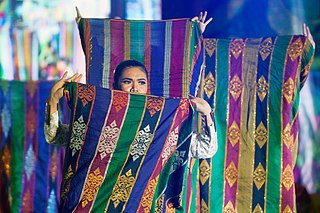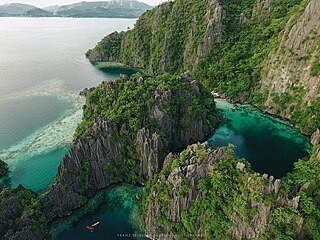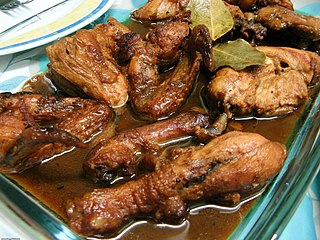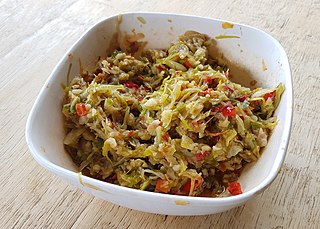
Turmeric is a flowering plant, Curcuma longa, of the ginger family, Zingiberaceae, the rhizomes of which are used in cooking. The plant is a perennial, rhizomatous, herbaceous plant native to the Indian subcontinent and Southeast Asia that requires temperatures between 20 and 30 °C and high annual rainfall to thrive. Plants are gathered each year for their rhizomes, some for propagation in the following season and some for consumption.

Lanao del Sur, officially the Province of Lanao del Sur, is a province in the Philippines located in the Bangsamoro Autonomous Region in Muslim Mindanao (BARMM). The capital is the city of Marawi, and it borders Lanao del Norte to the north, Bukidnon to the east, and Maguindanao del Norte and Cotabato to the south. To the southwest lies Illana Bay, an arm of the Moro Gulf.

Rendang is a Minangkabau dish. It is a rich dish of meat that has been slow cooked and braised in a coconut milk seasoned with a herb and spice mixture until the liquids evaporate and the meat turns dark brown and tender, becoming caramelized and infused with rich flavours.

The Maranao people, also spelled Meranao, Maranaw, and Mëranaw, is a predominantly Muslim Filipino ethnic group native to the region around Lanao Lake in the island of Mindanao. They are known for their artwork, weaving, wood, plastic and metal crafts and epic literature, the Darangen. They are ethnically and culturally closely related to the Iranun, and Maguindanao, all three groups being denoted as speaking Danao languages and giving name to the island of Mindanao. They are grouped with other Moro people due to their shared religion.

Tugaya, officially the Municipality of Tugaya, is a 5th class municipality in the province of Lanao del Sur, Philippines. According to the 2020 census, it has a population of 24,778 people.

Tourism is an important sector for Philippine economy. The travel and tourism industry contributed 5.2%% to the country's GDP in 2021; this was lower than the 12.7% recorded in 2019 prior to the COVID-19 lockdowns. The country is known for having its rich biodiversity as its main tourist attraction. Popular destinations among tourists include Boracay, Palawan, and Siargao. Despite potential, the Philippines has lagged in tourism industry behind some of its Southeast Asian neighbors due to political and social problems.

The generic term for condiments in the Filipino cuisine is sawsawan. Unlike sauces in other Southeast Asian regions, most sawsawan are not prepared beforehand, but are assembled on the table according to the preferences of the diner.
The Arts in the Philippines are all the arts in the Philippines, from the beginning of civilization to the present. They reflect a range of artistic influences on the country's culture, including indigenous art. Philippine art consists of two branches: traditional and non-traditional art. Each branch is divided into categories and subcategories.

Philippine adobo is a popular Filipino dish and cooking process in Philippine cuisine that involves meat, seafood, or vegetables marinated in vinegar, soy sauce, garlic, bay leaves, and black peppercorns, which is browned in oil, and simmered in the marinade. It has occasionally been considered the unofficial national dish in the Philippines.

Nasi kuning, or sometimes called nasi kunyit, is an Indonesian fragrant rice dish cooked with coconut milk and turmeric, hence the name nasi kuning.

Darangen is a Maranao epic poem from the Lake Lanao region of Mindanao, Philippines. It consists of 17 cycles with 72,000 lines in iambic tetrameter or catalectic trochaic tetrameter. Each cycle pertains to a different self-contained story. The most notable of which deals with the exploits of the hero Bantugan.

Yellow rice is a traditional yellow-colored rice dish in Spanish, Iranian, West Asian, Moroccan, Ecuadorian, Peruvian, Caribbean, Portuguese, Filipino, Afghan, Indian, Sri Lankan, South African and Indonesian cuisines. It is made using white rice made yellow with annatto, saffron or turmeric, ingredients used to give the rice its yellow color.
Intangible cultural heritage (ICH) includes traditions and living expressions that are passed down from generation to generation within a particular community.

Acar is a type of vegetable pickle of Maritime Southeast Asia, most prevalent in Indonesia, Malaysia, Singapore and Brunei. It is a localised version of Indian achar. It is known as atjar in Dutch cuisine, derived from Indonesian acar. Acar is usually prepared in bulk as it may easily be stored in a well-sealed glass jar in refrigerator for a week, and served as a condiment for any meals.
Java rice is a dish originating in the Philippines. It is a type of fried rice that utilizes turmeric as main flavor.

Paelya or paella (Spanish), is a Philippine rice dish adapted from the Valencian paella. However, it differs significantly in its use of native glutinous rice (malagkít), giving it a soft and sticky texture, unlike the al dente texture favoured in Spanish paella. It is also characteristically topped with sliced eggs. Filipino paelya does not use saffron, but is instead coloured with atsuete (anatto), luyang diláw (turmeric), or kasubhâ (safflower).

Palapa is a sweet and spicy Filipino condiment consisting of thinly chopped white scallions (sakurab), pounded ginger, turmeric (kalawag), labuyo chili, and toasted grated coconut (niog). It originates from the Maranao people of Lanao del Sur. The ingredients are mixed together and cooked briefly or cooked until somewhat dry. It is immediately stored in sealed jars (garapon) after cooking. It can be used as an ingredient in certain dishes or used as a condiment after briefly sautéing. Palapa can also be eaten fresh as salad dressing. Palapa is an important cultural symbol of the Maranao people and is a ubiquitous accompaniment at every meal.
Sinigapuna is a Filipino rice dish cooked with turmeric and other spices. It originates from Kalagan people of the Caraga and Davao Regions of Mindanao. It is similar to the Maranao kuning, and Indonesian nasi kuning.

Banjarese cuisine is the cooking tradition and cuisine of Banjar people of South Kalimantan in Indonesia. Banjar cuisine also found in neighbor countries as following Brunei, Malaysia to Singapore.
















